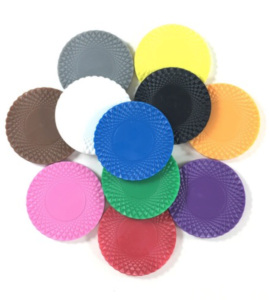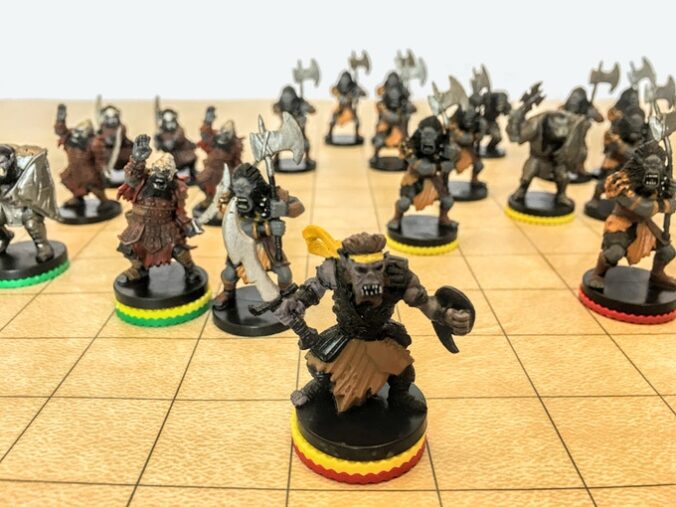I’ve been a big fan of using 1″ poker chips in RPG and wargames for years. Back in 2017 I pioneered the idea of Stoplight Damage™ and I sold sets of these tokens in my 5e Gamemaster Toolkit Kickstarter. Beyond their use in tracking damage in RPGs, I’ve also found them handy when differentiating squads of soldiers in 3+ player wargames. Need to differentiate your squad of six American WWII soldiers from the other two players with squads on your side? Just use sticky tack to affix 1″ tokens of the same color to your squad’s models.
Finding poker chips in a 1″ size can be a challenge. Here are the two suppliers I’ve used in the past.
Both the above suppliers sell their 1″ poker chips in various colors. The chips are reticulated with radial lines that let them easily stack and interlock but not slide around once stacked.
You can also use various 1″ plastic chips such as these but they might slip around under the model. You might try using some fine grained sandpaper to score the surface and give them a bit of friction.
If you’re wondering how Stoplight Damage™ works, see my text below adapted from my Kickstarter description.
Stoplight Damage Tokens
These special plastic tokens are sized to fit under standard 1 inch miniature bases and allow you to use Stoplight Damage™ rules to use tokens to track hit points. Run large scale encounters without the hassle of tracking hit points for each creature by hand.
Ever have a dozen Orcs on the battlemat, and have trouble keeping track of each creature’s hit points? Logistics of tracking a large number of minis can be challenging. Damage Counters make this easy.
Any damage done to Player Characters is tracked like you normally do: players track their individual damage levels. Damage dealt to non-player creatures and enemy creatures uses Stoplight Damage™.
Here’s how it works. There are green, yellow, and red damage tokens. Like a stoplight, the most favorable color is green, and the most unfavorable is red. The damage values of each token follows the values of American coins: 5, 10, and 25 (a nickel, dime, and quarter). Round damage up to the nearest 5. So if you deal 4 hit points of damage to an Orc, that rounds up to 5, and you’d place a green damage counter beneath the miniature. On the next hit, if you deal them 8 additional damage, you’d add a yellow counter beneath them.
Yes, the damage goes up slightly, but in most games it makes very little difference to the balance of the encounter. You can easily add another creature or up their total hit points slightly if you want, but in practice, it feels very organic and satisfying.
I’ve been testing this technique for many months in several different groups. Here is what people are saying:
- “These tokens make combat much faster and more enjoyable. It takes away all the tedious tracking of hp for each figure. I like the fact that you can see easily which figures are damaged, seems to better simulate a real conflict. They are AWESOME!!!” — John S.
- “They really streamline the process of HP tracking for NPCs and let the focus remain on the action.” — Mason A.
- “Great gaming hack! Helps both the DM and the players know the damage quickly. If you’re looking to speed up your combat, these are essential.” — John B.
- “I really dig the stoplight damage system. It’s an elegantly streamlined way to track damage. For the GM and players alike, it makes for more dynamic, action-packed battles. Plus, as a player, it’s fun to see the damage “stack up” on enemies.” — Chris Y.
- “The stoplight damage system was an eye opener for me because it shows how smooth combat can be. Streamlining damage to NPCs helps the game flow and allows players and GM alike to avoid the grind of hit-point counting, shuttling encounters into a quicker and less grindy experience.” — Jeff L.
Most creatures won’t use more than 2 or 3 counters before they die.




Recent Comments